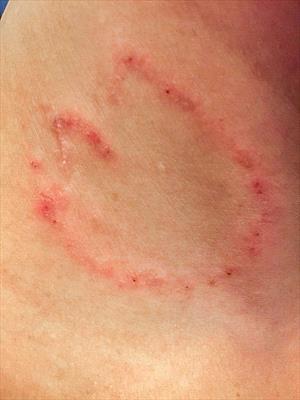ringworm Loretta Choi

Ringworm on a person's leg (specifically, Dr. Choi's husband) Photo by Dr. Loretta Choi.
“Look at this rash I’ve got, honey. It’ll go away if I put some cream on it,” said my husband Steven as he scratched his hand. Several days later, a second and then third ring of abnormal skin appeared on his leg and foot.
“It’s spreading like the plague!” he cried.
My husband is accustomed to strange rashes on me. The first time, it was the fast-advancing rash on my arm following a calf delivery on a dairy farm. Infected birthing fluid got under my gloves and resulted in a nasty rash tracking up my arm. I dropped by the hospital for antibiotics while between farm calls. The rash stopped dead in its tracks.
The second time, a kitten rescued from a dumpster nestled on my chest for a snuggle. Her purring was so sweet that I didn’t notice the bright hives and rash forming under my neck until it was too late, and in the tender moment I might not have even cared. I wasn’t sure what I was reacting to, but a shower was needed for both the kitten and me. No big deal, easy remedy.
The rash on my husband, however, was different. The numerous red, crusty and circular rashes were a sign of something ominous. Little did we know that we were about to enter a long dance with the infection known as (pause to hear the drum rolls) ringworm.
Contrary to the name, ringworm is a fungus, not a worm. The name describes the ring-shaped lesion that is commonly seen in humans; we are far less furry than our pets and it can be seen easily on us. The fungi belong to a fun group called dermatophytes. Several different species cause disease in pets and people. It’s a party!
In animals, ringworm can be seen in different ways:
- Patchy crusted circular bald spots appearing on the head, ears, limbs and paws
- Areas of thin, sparse and broken hairs or poor hair coat
- Dandruff
- Darkly pigmented skin or redness
- Itchiness
The dermatophyte feeds on the superficial keratin on skin, hair and nails. It infects the hair follicle, causing the shaft to break off at the skin’s surface, resulting in round patches of hair loss. The lesions can expand over the animal’s body, giving the appearance of a poor hair coat. The skin becomes red and inflamed, turning darkly pigmented if the infection becomes chronic.
Pets can also be carriers of ringworm without showing any obvious symptoms of the disease. Yes: like tuberculosis, a pet can carry the disease like a monkey on his back, but not have it. He’s able to share, though, and you too could be carrier (perhaps sans monkey) or have it. Share and share alike, you know.
Ringworm is contagious to pets and people. It can occur when there is direct contact with the dermatophyte or contaminated object. In addition, the dermatophyte can form a hardy spore that remains in the environment for long periods of time. The spores can be found on brushes, food bowls, bedding (yours and the pet’s), sofas and rugs.
Contact does not always lead to infection. Young children, elderly people or those with immune system problems are more susceptible to the sneaky ringworm. If it does develop, it can take from 7 to 21 days after exposure for lesions appear.
In my husband’s case, we never knew exactly where the ringworm infection came from. The possible culprits included:

- Our foster cat. Molly could have been a carrier despite having no symptoms. She was a scrappy old girl who came from a questionable background at the shelter. Furthermore, she loved sleeping on his pillow. She was the prime suspect and had no alibi. She was barred from her usual spot on the pillow even without definitive proof.
- Contaminated carpet. We had just moved into a fixer-upper and had started renovations. Ripping up old smelly carpet could have exposed him to a stockpile of dermatophyte spores. Given that the carpet wafted the scent of urine, we were quite convinced that previous animals loitered on the premise.
- Our neighbor. When we moved in, we greeted our new friends with a hearty handshake. My eyes fixated on a suspiciously round patch on top of her hand. She shrugged and dismissed the scaly redness as eczema. It was possible that she had an active infection without even realizing it.
Ringworm is best diagnosed by a fungal culture of affected hair or skin cells. Your veterinarian will send some samples from your pet to the laboratory. Results take anywhere from a couple of days to a month. You, of course, should see a physician.
You can wave an ultraviolet light called a Wood’s lamp onto the suspected pet and look for green fluorescence. Certain dermatophyte species will glow green when bathed in the glow of the Wood’s lamp. Sadly, this simple, cheap test is not definitive because some persnickety dermatophyte species do not fluoresce; they must be the highfalutin kind with names like Murgatroyd Ignatious Munroe III, and aren’t any fun at parties because they won’t shake their green. Furthermore, certain skin creams may fluoresce even without dermatophytes around. Maybe those creams sneak into ringworm parties without invitations.
Ringworm is treated in several different ways, depending on the severity. It is important to treat all cases of infection to prevent spread to other pets or people. If there is more than one pet in the household, either keep them separated (that is so much fun, you’re going to love it!) or treat them all (even more fun!) This will help prevent the infection from travelling back and forth between them. Let me point out this is not a condition you want to repeat a cycle, as once is far more than enough, particularly when medicated shampoo is needed.
- Topical treatment: In mild cases, medicated creams can be used on the skin. Medicated shampoo is also recommended to help eliminate the dermatophyte from the fur. Wear gloves.
- Oral medication: In most cases of ringworm, oral anti-fungal medication is required for effective treatment. Several different medications are available and your veterinarian will explain the best choice. Treatment varies depending on the response of the patient: think of my husband insisting some over the counter cream could take care of it. Ringworm is no wimp, Steven. Anyway, your pet or spouse may need to take medication for several weeks. This is to ensure that the dermatophyte is fully eliminated and doesn’t return when medication is stopped. Two negative laboratory ringworm cultures are required before treatment is considered successful.
- Environmental Decontamination: Cleaning the area in contact with the pet is essential. Remove all pet hair and dander using a vacuum. Dispose of the debris carefully as it is contaminated and infectious. Use a 1:10 bleach dilution on objects and surfaces, making sure the mixture has contact for at least 10 minutes. Have carpets professionally cleaned if possible. Ringworm spores can survive for long periods of times when embedded in carpet and household steamers are often not strong enough to destroy them. Wear gloves.
Months later, my husband was finally cleared of the ringworm infection. We never did solve the mystery of its origin; it remains a cold case. The ordeal took many visits to the physician to find an effective treatment. He had the topical therapy, oral medication, and anti-fungal shampoo. We decontaminated the whole house and finished the renovation. Not a speck of carpet remained for the spores to hide in. Even Molly was shiny and soft after multiple anti-fungal shampoo sessions. My husband and I sighed with relief as the angry ringworm lesions faded.
As we relaxed on the porch of our new home, we saw the neighborhood children come out and dance in a circle. “Ring around the rosie, pocket full of posies,” they sang. With a laugh, we agreed that a ring, on the rosie or elsewhere, was not a dance we wanted to do again!
4 Comments
Janet Eckstrom
May 21, 2018
Laura Browne
May 14, 2018
Sienna
May 14, 2018
Maria Deng
May 14, 2018